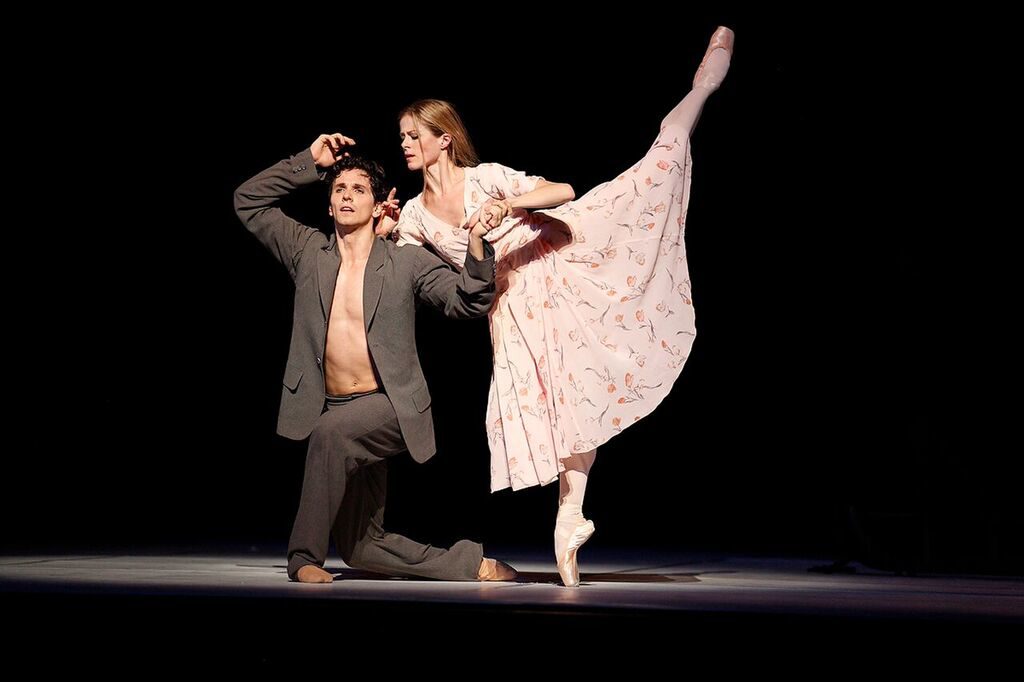Nijinsky at the NAC: a truly cathartic encounter between the dancer and his creations

Photo:Chris Sonnemann
The National Ballet of Canada’s staging of John Neumeier’s Nijinsky, the artist who, by his personal and professional life, has certainly had the most influence on contemporary dance in the world, will go down in the annals of dance drama performance. For the spectator, it does help if one is aware of the history of the Ballet Russe and the different individuals who worked with Nijinsky during his brief professional life because Neumeier’s vision of the work does not try to reproduce autobiographical accuracy or even imitate the many performances that attracted attention to Nijinsky’s dancing . His emphasis is elsewhere.
The narrative thread is set up from the opening moment when in 1919, friends, colleagues and family are invited to attend a final performance in the St. Moritz hotel ballroom. Guillaume Côté (Jan 25) as Nijinsky, appears showing the dancer’s various styles and steps to an adoring selected public, accompanied by a pianist playing Chopin. Slowly something disquieting takes place. The ghost –like figure of Serge Diaghilev (Ben Rudisin, Jan. 25) emerges as an evil shadowy presence at the back, watching the dancer from afar.
Rimsky-Korsakov and Shostakovich as powerful musical expressions under the excellent direction of David Briskin, inspire and respond to the emerging protagonists of this tragic life as the set (also conceived by Neumeier) morphs away and the young Nijinsky is projected into his own world of delusion, and deep disturbance. The frantic characterization and exploding physical energy that Côté (Jan. 25) brought to the performance of this extremely challenging role which required all the acting ability he could show was spell-binding and the dancer succeeded brilliantly in all ways. .
We see how the characters created by Nijinsky, (the Spirit of the Rose, Mallarme’s “Faun”, the Golden Slave from Scheherazade, Harlequin, Petrushka), each one identified by his own specific steps and gestures, appears neither as an imitation of Nijinsky’s performance nor as representations in a story but as signs of a deeply troubled psyche, the permanent and multiple undercurrents of this brilliant artistic conscience that indicate the conflict between the product of the dancer’s creative world and his own daily relationship with the exterior world.
The moments when he meets and courts his wife on the boat and and then eventually marries her, are emblematic of aspects of this troubled relationship. As he expresses his love for Romola performed by Heather Ogden(25), a beautifully lithe dancer with a most delicate point and almost ephemeral symbolist presence, the Faun moves in (Francesco Gabriele Frola, 25) using Nijinsky’s well-known steps from the Grecian urn that so shocked the world at that time, only to signify the seductive sensuality of this animal creature who is right there to keep his arms around the new bride and insure there is uninterrupted intertwining of the two facets of the lead male figure. All the while we sense that the predatory Diaghilev is still in the background weaving his spell on the fragile psyche of this young man. The subconscious world of Nijinsky is a terrifying place and the choreographer has captured that with great maîtrise because he also appears to be a gifted psychoanalyst as well as a great artist of the stage.
Act II presented violent images showing how the war, and perhaps even images of the revolution , exacerbated the internal conflict, projecting crowds, the chaos and torment of the outer world and his ultimate alienation from all those around him, especially the moment when the powerful female dancer (Jenna Savella, 25) in a brown body suit hurled herself into the rhythmic marching of the army and almost self-destructed in front of us. This dancer made other extremely striking appearances as Bronislava Nijinksa, Nijinsky’s sister who was also a choreographer.
The intertwining, the trembling that also suggested the instability of the unnerving military atmosphere, associated with the predatory atmosphere of the sacrificial rites of spring, and the presence of Nijinsky’s brother Stanislav (Dylan Tedaldi, 25) a disturbed and badly broken down human being, are all located in the context of the figure of Petrushka (Johnathan Renna, , 25) who performed Nijinsky’s torment through this unhappy clown and his puppet-like movements.
As a terrified and pathetic figure, torn apart by the violence around him, he seems to be a projection of the inner horror that the artist was not able to absorb. He was accompanied by a ballerina (Jillian Vanstone) who also performed various roles in this huge cast that was a wealth of impeccable dancers. In fact this choreography brought out an even deeper understanding of Nijinsky’s work emphasizing the cathartic nature of the emotional relationships between the imaginary figures and the living dancer, something that the legend growing around the dancer has tended to ignore.
A truly and deeply moving experience that has given us a completely new gaze into the Ballet Russe , into the life of one who has become one of the great artistic figures of our time. It also completely transforms the way a dance biography functions to express an underlying reality that is not easily available to the eye of the beholder. This is a ground-breaking performance of extreme beauty!
Nijinsky continues in Southam Hall of the NAC, January 25- 27/2018 at 8pm. Performance lasts two hours and 20 minutes.